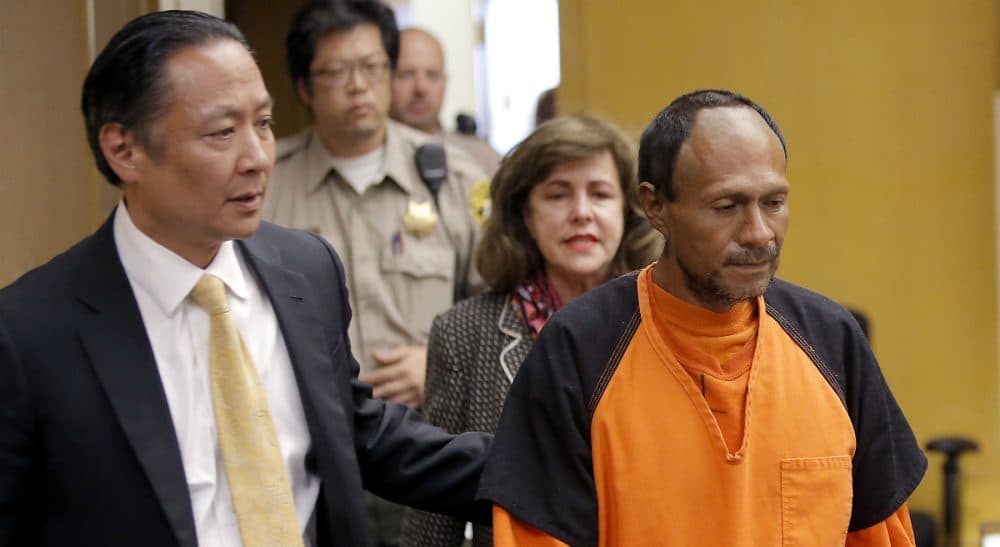Advertisement
Undocumented Immigrants And The Paradox Of 'Sanctuary Cities'

In the wake of a startling murder in San Francisco, the existence of 200 “sanctuary cities” is being furiously debated. It touches on many of the sore spots in our struggle with immigration policy—how to treat those here without authorization, federal versus local control, and the dynamics of law and crime.
Kathryn Steinle, a 32-year-old San Franciscan walking with her father on the city pier, was killed on July 1 for no apparent reason, allegedly by an unauthorized immigrant named Juan Francisco Lopez-Sanchez. The killer, who said he found a gun that went off accidentally, had been deported five times to his native Mexico and has a long felony conviction record, though none for violent crimes.
Because San Francisco is a sanctuary city, however, Lopez-Sanchez was a free man when he allegedly shot and killed Ms. Steinle. Sanctuary cities have pledged not to cooperate with federal agencies seeking to round up unauthorized immigrants for deportation. While different cities have different rules, the basic idea is that the feds have unfairly deported Mexicans and other Latinos, often breaking up families. City employees, including police, are prohibited by these local rules from asking immigrants for proof of citizenship or legal presence.
Cambridge, Somerville, Chelsea and three other Massachusetts cities are such sanctuaries. Providence and the entire state of Maine also have such rules.
The cacophony that followed the killing has taken familiar lines—the GOP presidential hopefuls, for example, condemning San Francisco and the whole idea of such sanctuaries. Democrats have been more measured. Hillary Clinton was critical of this particular situation, where a multiple felon was allowed to remain at large even as federal immigration agents sought him, but she broadly supported the concept of sanctuary cities.
As Clinton and immigration activists point out, the sanctuary idea aids law enforcement in communities with large numbers of unauthorized immigrants, where residents are less likely to report ordinary crime or cooperate with police if they sense they are at risk of deportation. It is also broadly noted that immigrants, legal or not, commit fewer crimes than native-born Americans.
Sanctuary cities have pledged not to cooperate with federal agencies seeking to round up unauthorized immigrants for deportation.
But the sanctuary issue is not a simple for-or-against proposition. One opinion immigration activists have held firmly for several years is that immigration policy is a federal prerogative. When Arizona was passing onerous immigration restrictions, including precisely the sorts of official demands for papers that sanctuary cities bar, the laws were challenged and mostly overturned by the U.S. Supreme Court in 2012. What’s notable in this is that immigration activists then applauded the assertion of federal prerogative.
Justice Kennedy, writing for the majority, referred to “the Federal Government’s broad, undoubted power over immigration and alien status” and its responsibility for foreign relations, both of which are explicitly mentioned in the Constitution. Having 50 or more sets of rules about immigrants, moreover, would be unwieldy and unnecessary.
That court decision seemed to establish federal supremacy on immigration, but, simultaneously, the sanctuary movement was growing. Its growth was in part a response to more aggressive policing, using local law enforcement to share data with federal immigration officials in order to identify those here illegally. Partly as a result of these new methods, record deportations of up to 400,000 people annually have taken place during the Obama administration.
Advertisement
Enormous numbers of families were split up by these arrests and deportations, sometimes involving long stays in a much-criticized detention system. Systematic discrimination against Latinos can be gleaned in the statistics as well, from the sheer numbers of those arrested to their treatment by the courts and law enforcement.
Sanctuary for the innocent is one thing. Protection of criminals is altogether a different, troubling matter.
The excesses of the legal system in deportation parallels another unintended consequence of immigration politics—namely, the efforts to secure the border disrupted a longstanding pattern of Mexican agricultural workers migrating seasonally into the U.S. and then returning home. When the costs and dangers of crossing the border became higher, many of them stayed and started families. Harsh border enforcement and the need for labor prompted the large numbers of unauthorized immigrants.
So we have yet another paradox of immigration, this time an issue of federalism—what jurisdiction has the right of control? As long as sanctuary meant harboring non-criminal immigrants who could be innocent victims of the dysfunctional federal system, the local protections seemed humane and largely warranted. But when a felon is in the mix, as happened in San Francisco and (rarely) elsewhere, the federal prerogatives seem more sensible and necessary.
It really shouldn’t be too difficult for local jurisdictions to sort out the bad apples. Sanctuary for the innocent is one thing. Protection of criminals is altogether a different, troubling matter.
